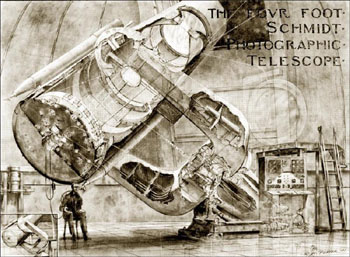Schmidt camera

Russell Porter schematic of the Palomar 48-inch Schmidt camera.
A Schmidt camera is a type of photographic telescope that uses a spheroidal primary mirror with a corrector plate at its center of curvature to eliminate spherical aberration. It is named after its inventor, the Estonian-born instrument-maker and astronomer Bernhard Voldemar Schmidt (1879–1935).
Schmidt cameras address a weakness of reflecting telescopes that are based on parabolic mirrors, namely, that accurate focusing only occurs for light falling on the center of the paraboloid. Light falling at some distance from the center is not correctly focused owing to the optical distortion in the image, known as coma. This limits the use of parabolic reflectors to a narrow field of view and thus precludes them from accurate survey work and the construction of star maps. The Schmidt camera, by contrast, has an extremely fast focal ratios that provide very high-quality images, free from coma and astigmatism. The focal plane of the simplest design is not flat, but strongly curved, and is furthermore positioned well inside the body of the instrument, where it is difficult to reach with an eyepiece. Hence the system is almost always used as a camera. Because the focal surface is curved so, too, must be the photographic plates and films.
A Baker-Schmidt telescope is a modified type of Schmidt camera designed, by James Gilbert Baker (1914–2005) of Harvard College Observatory in 1940, to produce an image free of astigmatism and coma. It uses a secondary convex mirror and a photographic plate that faces outward from the main mirror (rather than toward it, as in a conventional Schmidt).


